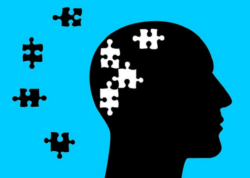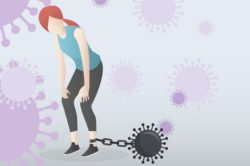I began writing this post in April of 2020 as a part of a much larger post on COVID and never finished it. I am publishing it now in its unfinished state in the hopes that others might be inspired to pick up where I left off. Although the current hypothesis regarding COVID morbidity and mortality involves micro-coagulopathies believed to emanate from platelet dysfunction, based upon my research, I contend that mitochondrially driven hypoxia cascades are still responsible. I will publish some thoughts on this in a subsequent post. For now, consider the role of molecular hypoxia as a key component of COVID complications.
Mitochondrial Energy Failure
When one has a hammer, everything becomes a nail. My hammer, my framework for understanding every illness, is mitochondrial function. Mitochondria, because they produce cellular energy (ATP), the single most important, non-negotiable requisite for survival, sit at the nexus of health and disease. Absent the ability to produce sufficient ATP, death is imminent. We are seeing this play out on a large scale with the coronavirus (COVID-19). The progression and patterns of illness reported associated with COVID mortalities share striking similarities with what might be deemed an energy failure, where mitochondria initiate every tool in their armament to fight the battle but have not the resources to contain the threat or manage the consequences of such a brutal battle, and so instead, are forced to withdraw, shut down, and slowly die off.
The key pathology of COVID, acute respiratory distress syndrome (ARDS), the one responsible for all of the morbidity and much of the mortality associated with COVID, can be linked directly to mitochondrial failure, as can many of the associated pathologies attributed to the COVID disease process itself. Inasmuch as these same processes also develop with other viral, bacterial, or fungal agents, it suggests that while COVID is undoubtedly unique in its structure, its mechanisms, and its virulence compared to other pathogens, this uniqueness may not be the only variable to address. If entirely different pathogens or stressors can cause similar response patterns, then perhaps it is not the uniqueness of the pathogen that matters as much as the strength and agility of the individual response. That is, perhaps the host response contributes, if not more, at least equally, to pathogenicity. Perhaps distinctions in host response offer more salient clues about surviving this or any other threat than the endless taxonomy of distinctions between threats. And finally, perhaps the use of mechanical ventilation as the treatment option has become medicine’s hammer for too many nails.
Ever since this pandemic began, I have suspected that the respiratory distress syndrome developing with COVID was related more to mitochondrial failure than any mechanical problems with respiration for which the ventilators are designed. Indeed, I suspect that given the high mortality rates associated with mechanical ventilation of any cause, 30-45% according to pooled data, in a good portion of these cases, we have missed a key variable. I think at the root of these deaths and the severity of COVID is molecular hypoxia. Molecular hypoxia emanates not from obstruction, though obstructive fibrosis and fluid build-up may develop later, but from the bottom up; from the inability to utilize O2 in the mitochondria, and thus, efficiently produce ATP. This then initiates a host of self-reinforcing cascades that lead to poor blood oxygenation, sometimes perceived as ‘air hunger’ by patients and often correspondent to an altitude sickness-like effect.
I believe that molecular hypoxia is also responsible for the deregulated immune and inflammatory responses noted in COVID and in a long list of other conditions, many of which impact COVID severity. I believe that molecular hypoxia is both the cause and consequence of disrupted iron homeostasis, as well as the seemingly chaotic autonomic response, the progressive fibrotic and fluid build-up in the lungs, and finally, death by either by a sepsis-like syndrome that leads to multi-organ failure or cardiac arrest. With regard to heart function, it should be noted that disparate or inconsistent ATP availability affects rate and rhythm both in the cardiomyocytes themselves but also via the brainstem with chaotic autonomic nervous system (ANS) signals. In other words, with mitochondrial collapse, death happens by a thousand possible cuts.
What Causes Mitochondrial Collapse?
We like to think of mitochondria as these magical black boxes that provide sufficient ATP no matter what we throw at them. Most of us were taught, absent outright starvation or ‘rare’ mitochondrial disorders, that mitochondria would happily and efficiently do their thing – produce sufficient ATP to meet the demands of living. That is just not the case. Any number of toxicants will damage mitochondria, including pharmaceuticals. That is why what is in one’s diet matters as much or more than the calories in, calories out equation recognizes, and why genetic mitochondrial disorders are not as rare as once believed.
Mitochondria require micronutrients, which many of our diets are starved of, to breathe, to consume O2, and utilize it to convert to ATP. With insufficient micronutrients, even in the face of sufficient or abundant macronutrients, hypoxia develops and with it, each of the cascades noted in COVID, albeit on a lesser scale, are enacted. The metabolic disarray plaguing much of the western world is a direct result of chronic, mitochondrially-driven hypoxia, which is a direct result of micronutrient malnutrition coupled with a continuous onslaught of chemical toxicants. This means that comorbid conditions linked to COVID severity and mortality, share common origins and that COVID, as unique as it is in its delivery of viral pathogenesis, in many ways, enacts exactly the same mitochondrial pathways as everything else but perhaps unlike other viral pandemics, is developing against the backdrop of longstanding, often epigenetic, mitochondrial insufficiency e.g. pre-existing hypoxia cascades.
So while COVID is a particularly virulent pathogen, its virulence is increased exponentially by our own ill-health; by a lifetime (or many lifetimes, if we consider the epigenetic consequences of these chemicals and dietary choices) of accumulated mitochondrial damage. With COVID, it is as if we are asking our bodies to run a marathon while starving and dodging bullets. Many of us simply do not have the energy to make it through because we are already hypoxic, starved for nutrients, and generally, exhausted. And while with age comes mitochondrial decline, age is not the defining variable. The defining variable is mitochondrial health, which if prescription data are any indicator, is progressively declining across all age groups, but most notably, among the young.
If this hypothesis is correct, then how do we survive? By going old school. By supporting the mitochondria so that they have the energy to manage and contain the threat. Oxygen is vital for life. Mitochondria are vital for proper oxygenation. Nutrients are vital for functioning mitochondria. Support the mitochondria and perhaps our capacity to withstand this virus will improve.
We Need Your Help
More people than ever are reading Hormones Matter, a testament to the need for independent voices in health and medicine. We are not funded and accept limited advertising. Unlike many health sites, we don’t force you to purchase a subscription. We believe health information should be open to all. If you read Hormones Matter, and like it, please help support it. Contribute now.
Yes, I would like to support Hormones Matter.














The post by Dr. Marrs exposes a reasoned explanation, not only for Covid, but for disease in general. Our lives are spent in an environment that consists of “attack and defense”. Our attention has been focused on the “attack” and the nature of “defense” has been almost completely ignored. The mitochondria are the “engines” of function and oxidation is their method of energy production. Hypoxia is a key but micronutrients enable oxidation and their deficiency causes the same damage as lack of oxygen and has been referred to as pseudohypoxia (false lack of oxygen). So the key to disease is nutrition.
@ dr londsdale
I congratulate you on your phenomenal work on b1.
Thanks alot for your amazing articles.
My question is can MND be cured by b1 mega doses??? And what supplements would you recommend??
All I know is it all stress induced due to major fjnancial loss.
She is 5o years of age.
Excellent article!
This post requires comment. I found it by accident because I was scanning some of the posts that have been written on this website. Connie asks the question “can we educate neurologists? “. The answer, I am afraid, is that American physicians have come to the concrete conclusion that vitamin deficiency in America is completely nonexistent! Hence there is a universal medical ignorance. The many symptoms associated with thiamine deficiency are often determined by physicians as “psychosomatic”. This, unfortunately, defends their ignorance because the laboratory tests that they do does not even approach the reality that can be detected by the use of proper tests. Unfortunately, this ignorance is so widespread that the Mayo Clinic and the Cleveland Clinic have both published the fact that erythrocyte (red cells) transketolase activity is the proper methodology to detect deficiency. When they find that this is perfectly normal, they tell the patient that thiamine deficiency does not exist. The trouble with this is that thiamine deficiency in America is widespread because of the high intake of empty calories. Yes, the blood thiamine will be found to be normal as will the transketolase because it is the ratio of calories to the vitamin content that decides the issue. The thiamine content of the blood would be enough for a healthy diet but insufficient for the common American diet. For example, the diet in Osaka Japan, where centenarians are relatively common, is high in micronutrients and low in calories. The very reverse of that exists in America. Our book “Thiamine deficiency disease dysautonomia and high calorie malnutrition” is readily available on Amazon books and should be read by all physicians. Even the title is likely to be dismissed as the brainchild of idiots!
I still don’t understand how this can be!
Even a brochure/paper/guideline published by the WHO in 1999 (!) says:
“The requirement of thiamine is increased when carbohydrates are taken in large amounts and is raised during periods of increased metabolism, for example, fever, muscular activity, hyperthyroidism and also during pregnancy and lactation.” (Page 5 under “Risk Factors”)
and
“Mild thiamine deficiency can be seen in people who have high carbohydrate intakes and low thiamine intakes e.g. in people whose staple food is polished rice, especially if their diet containsanti-thiamine factors (tea, coffee, betel nuts, raw fermented fish) and in population groups who consume large quantities of refined carbohydrates in the form of sweetened carbonated drinks and candies.” (page 11)
https://www.who.int/nutrition/publications/en/thiamine_in_emergencies_eng.pdf
This should be distributed and taught in med school!
Thanks for all you are doing. Is there any way you can educate Neurologists, or are they too resistant to receive the information? I just learned that I have had Beriberi for 25 years and I feel like crashing Neurological conferences worldwide with my own little lecture. I’m oscillating between thankful and irate; I’m not sure I’ll be able to let this go. Anyway, five months of Covid-19 and nine months of Spironolactone made my thiamine deficiency worse, so that I was finally able to zero in. I got ascending paralysis for the first time, which brought thiamine deficiency onto my radar. Then I read Dr. Lonsdale’s and your research. I immediately started taking the B-complex I already had (mostly ineffective due to malabsorption) and ordered Benfotiamine. After reading more research I ordered Sulbutiamine. I take them with magnesium, which I have been taking for 20 years (cured my migraine headaches). My paralysis has reversed except for a little lingering weakness in my right thigh and all of my “Dystonia” symptoms are reversing. I lost the prime of my life to a vitamin deficiency! Besides all the Neurologists, I also went to see a mitochondrial disease specialist at Cleveland Clinic 10 years ago. He said there was clearly something going on because so many of my amino acids were off, but he did not see mitochondrial disease. I’m sure that my Generalized Dystonia and Spasmodic Dysphonia will reverse because of the phenomenal response I’ve had in just two weeks. I’m hoping that my Common Variable Immune Deficiency and IBS will also respond. My last home IgG home infusion felt completely different and very weird. The best way I can describe it was that I could smell and feel thiamine exploding into every cell of my body. My eyesight has even improved. I want to document this but I can’t find a physician who will order an Erythrocyte Transketolase or a Thiamine Pyrophosphate Effect. Do you know of a Cleveland Clinic or other Ohio doctor I can see for this? My zip is 44667. Thank you! Connie